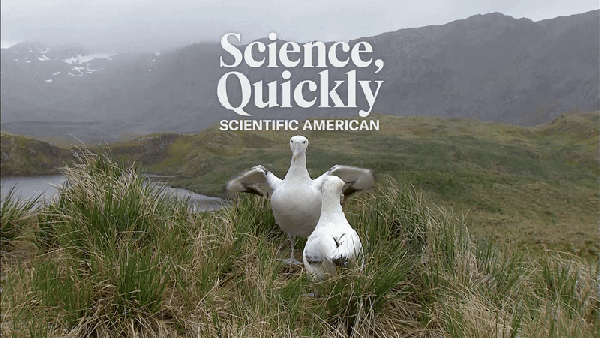Joseph Polidoro: Imagine for a moment that you’re a very hungry bird soaring over 30-foot ocean swells in high winds, with no land for thousands of miles.
How do you know where you’re going?
If you’re a wandering albatross, you listen.
[CLIP: Music]
According to a new finding in October’s Proceedings of the National Association of Sciences USA, this seabird navigates using sounds below our thresholds for hearing.
For Science, Quickly, I’m Joseph Polidoro.
The wandering albatross thrives in the circumpolar band of ocean north of Antarctica—a windswept region that the world’s best sailors say has the most inhospitable seas on the planet.
On the Southern Ocean’s islands where they nest and brood, one wandering albatross parent tends the nest while its partner takes to the sea, traveling as much as 10,000 kilometers as it forages for scattered prey. The bird must eat enough to fuel its turn on the nest, which can be a long time ...
Samantha Patrick: Birds might go for, perhaps, a minimum of four or five days, up to 30 days.
Polidoro: Samantha Patrick is a marine ecologist at the University of Liverpool in England and a co-author of the study.
Wandering albatrosses actually gain weight on these long trips because they’re extremely efficient flyers.
Sophie de Grissac: It almost never beats its wings. It’s quite fascinating to see them flying in the winds. When they’re flying, their heartbeat is the same as when they’re resting.
Polidoro: That’s Sophie de Grissac, an ornithologist and a researcher at the French National Museum of Natural History in Paris, who wasn’t involved in the study.
With their long wingspan—the longest of any bird, maxing out at nearly 12 feet—wandering albatrosses use wind, air pressure gradients, and gravity above the swells and waves to soar for thousands of miles, reaching top speeds of 45 miles an hour.
Basically, wandering albatrosses don’t fly. They soar.
De Grissac: The more distance you cover, the more you may find food.
Polidoro: The wandering albatross’s keen senses of sight and smell help it locate prey. But these senses are good for about 100 kilometers—a distance the bird can travel in as little as an hour and a half. So how does the albatross know where to soar toward?
Patrick: There does seem to be this large gap in information that they’re able to access.
Polidoro: A clue came in a chance encounter on the way to the Crozet Islands, part of the French Southern and Antarctic Territories, where Patrick was headed to study albatrosses.
Patrick: On the same vessel were some researchers from the [United Nations]. They were going to work with the hydrophone station that’s used to monitor nuclear tests. It also gathers infrasound data. And we came up with the question of whether seabirds could use infrasound. And it was clear that no one had really thought about this before, and that’s where the idea for the project came from.
Polidoro: Infrasound is any sound below 20 hertz, where human hearing starts to drop off. At the very low end of the infrasound spectrum are microbaroms—very low-frequency sounds between 0.1 and 0.6 Hz that are detectable across thousands of miles.
Natasha Gillies: Microbaroms are generated by the collision of ocean waves.
Polidoro: Natasha Gillies is a seabird ecologist at the University of Liverpool and a co-author of the study.
The constant hum of microbarom infrasound is called “the voice of the sea.” It’s present everywhere, all the time. But it’s unevenly distributed.
Gillies: Where you have more energy in the ocean system because you have wavier areas or windy areas, then you get louder microbarom regions.
Polidoro: Ideal soaring conditions for wandering albatrosses.
Patrick: But it also gives them information about standing ocean waves, and this is often caused by things like storms. So it would enable birds to try and gauge where storms are, potentially. So this might be be cause they want to move toward windier areas that could be optimal, or they might want to move away from windy areas if they’re too strong, and they want to try and avoid storms.
Polidoro: Directly testing this apex predator’s hearing is not an option. So Natasha and her colleagues arrived at a creative experimental solution: Get a large enough sample of wandering albatross flight paths. Then, using wind and infrasound data, create a sound map of the total flight area—a map of microbaroms across space and time. Send out another set of albatrosses equipped with sensors to field check the sound map. Finally, overlay the birds’ flight paths on the sound map.
Gillies: So essentially what we can get is: if you put an albatross at point X in space and on this day in time, what infrasound would it be likely to hear and experience?
Patrick: We didn’t have an expectation at the beginning that they would move toward louder or quieter areas.
Polidoro: What the team found is that wandering albatrosses aren’t exactly wandering. Instead they seem to use microbaroms to head toward ideal wind conditions.
Ventura: Looking at the soundscape and how the birds move, you know, almost following this wave of sound, I found that beautiful.
My name is Francesco Ventura, and I’m a postdoc at Woods Hole Oceanographic Institution.
Polidoro: He wasn’t involved in the study either.
Ventura: It’s another world–that’s the thing. It’s something that we cannot fully understand, I think; we are humans and we just cannot even imagine how that would work for us. But it seems to be working fine for them because they have been doing it for a long time.
They seem to be [reading] what’s going on and kind of orienting toward that. You know that is something that is…it’s SciFi.
Gillies: We know that there is something about infrasound that they want to move toward, that they like, that is beneficial to them in some way.
Ventura: It was kind of a badly needed paper at this point because it sheds some new light into a fundamental question that is at the core of a lot of marine megafauna research in general but also at the core of seabird research, which is: “How do they manage to find food in such a vast area?”
Polidoro: This reliance on infrasound may actually extend to other species, too.
Gillies: Most seabirds are highly dependent on wind for movement. It seems to be involved in animal behavior in a lot of contexts, in a lot of different species.
Polidoro: They include whales, elephants, pigeons and peacocks.
Gillies: So I would be very surprised if this was in any way unique to wandering albatrosses.
De Grissac: So albatrosses have had a very long time to evolve ways of feeling the environment—lots of ways they can perceive what’s around them. And I think because they really need this condition, this stormy conditions, these winds, it makes perfect sense that it would have evolved more than one way of finding them.
Gillies: I think it’s a really nice reminder of the different sources of information animals might be using—especially in this sort of environment that is so featureless—and how animals can still extract so much information and context out of that despite there seemingly not being much there.
De Grissac: Evolution in animals is almost always very surprising. When you study the evolution of the animal closely, you find remarkable things, remarkable inventions.
Polidoro: Science, Quickly is produced by Tulika Bose and Jeff DelViscio. Our music is composed by Dominic Smith.
Subscribe to Science, Quickly wherever you get your podcasts. If you like the show, give us a rating or review.
For Science, Quickly, I’m Joseph Polidoro.
[CLIP: Music]

